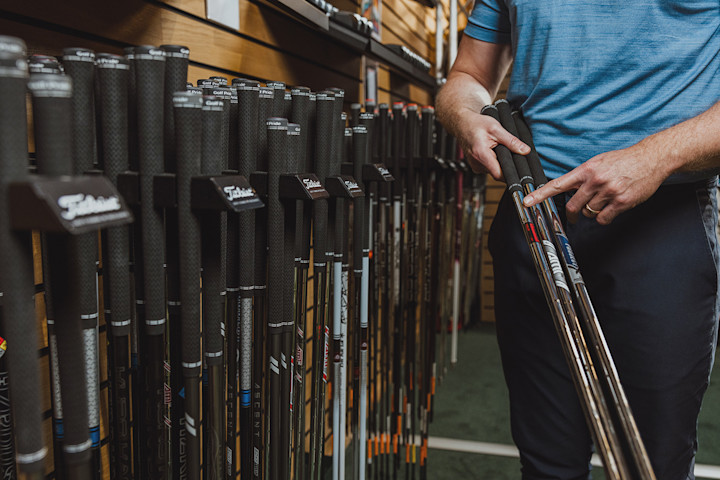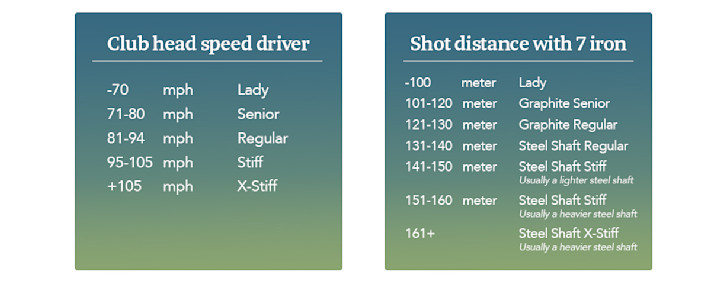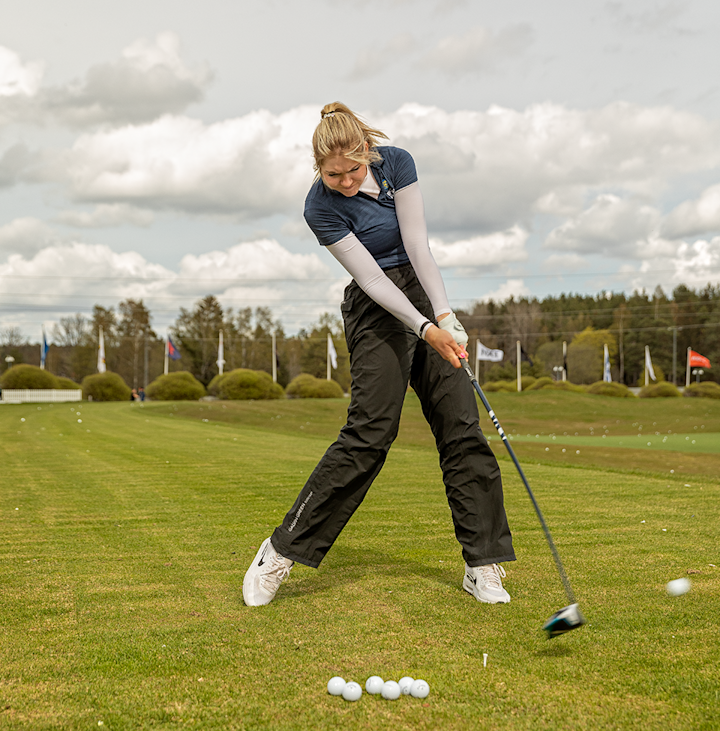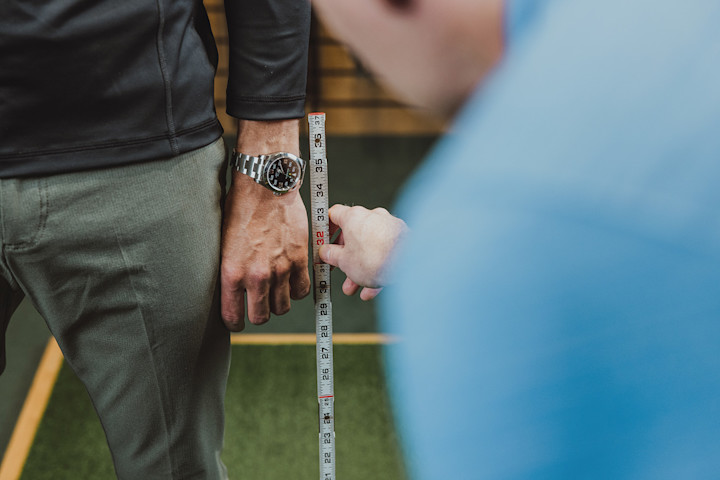
Everything you need to know about golf shafts
We can all agree that golf becomes more enjoyable (and perhaps a bit easier?) when playing with the right equipment. Your swing and ball strike are important parameters for how the ball flies, but the shaft of your golf clubs can also have a significant impact. Let's explore this further!
The shaft acts as the club's engine and should harmonise with your swing. Being careless with shaft selection can result in your new clubs not performing optimally, simply worse than you had anticipated. Therefore, it's crucial to find the right flex, weight and material from the start. A useful thought to keep in mind is that there is no standard shaft that suits all players. Whether you're at an intermediate or professional level, the shaft should be chosen based on your characteristics as a golfer.
Psst... there's a brief summary at the bottom of the article.
Types of materials in a golf shaft
Steel Shafts
Today, we see most men using steel shafts in irons and wedges. Steel shafts are stable and reduce shaft twisting at impact for players with a powerful swing.
Graphite Shafts
Have a lighter weight than steel shafts. The lighter weight makes it easier to increase swing speed, which is why graphite shafts are always used in metalwoods. Since graphite is lighter than steel, it's also suitable in irons for players with a lower swing speed, such as juniors, senior men, and ladies. Another thing about graphite shafts is that they can be painted in different colours and become more unique than steel shafts, which most often have the classic chrome finish. Graphite shafts are somewhat more expensive to manufacture, and therefore iron sets with graphite shafts usually have a higher price.
Multi-material
Currently a niche market, but this could change in the future as club manufacturers continuously seek revolutionary technologies to improve shafts. One example is shafts primarily manufactured in steel but with a graphite tip, combining the stability of a steel shaft with a softer/lighter tip to enhance feel, shot distance, and reduce vibrations. There are also shafts manufactured from titanium and similar materials, though these are produced in very limited quantities.

What does flex mean, and what different shaft stiffnesses are there?
Flex refers to the stiffness of the shaft. Your swing speed determines which flex suits you best. The higher the speed of your swing, the less flex you should have in your shaft – and vice versa. This ensures that the shaft provides the desired catapult effect and generates distance in your shots. There are essentially five different flex options that a golf club can have, whether we're talking about irons or metalwoods:
Lady
A soft shaft with a length adapted for ladies. Usually has a low flex point to help the player achieve more distance and height in their shots.
Designations for ladies' shafts: L, Lite, Ultra Lite, 4.0, 4.5.
Senior
Primarily designed for men with lower swing speeds, but also suitable for ladies looking for a slightly longer and stiffer shaft compared to a ladies' shaft.
Designations for senior shafts: A, SR, 5.0
Regular
The standard shaft for men and the most commonly played shaft flex.
Designations for regular shafts: R, 5.5.
Stiff
Shaft designed for players who hit the ball with high swing speed. These shafts combine torsional rigidity with stiffer flex to maintain a lower ball flight and provide control in shots.
Designations for stiff shafts: S, 6.0.
X-Stiff
The stiffest shaft, designed for players who hit the ball with extremely high swing speed.
Designations for X-stiff shafts: X, 6.5.
In the image below, you can find a quick guide on how to think when choosing shafts for your driver and irons.

There is an incredible variety of shaft manufacturers and models, which means the flex can vary between brands and models. A lighter shaft generally plays softer than a heavier one.
Studies show that around seven out of ten golfers struggle with slicing. Many golfers believe that a stiffer shaft is the solution, but in most cases, it’s the opposite. A softer shaft will hit the ball with more loft and a more closed clubface than a stiffer shaft. If you have slice issues, a shaft that is too soft is usually better than a stiff one. A stiffer shaft hits the ball with lower loft and a more open clubface, which results in a lower ball flight and more to the right. If you hit hard, high, and have hook problems, a stiffer shaft is preferable.
However, you should never forget that your own feel ultimately determines what is right or wrong. Many golfers find that a “too hard” shaft gives a sense of stability, even if you lose a bit of distance on your shots. At the same time, a shaft that is too stiff can feel rigid and uncomfortable to hit with.
What is the kick point in a shaft?
The kick point (Kickpoint, Bendpoint, Flexpoint) is the point where the shaft bends the most. The kick point affects ball flight – a low kick point produces a higher ball flight, and vice versa. Although the effect is small, it is still measurable.
Your wrist release can also influence which kick point is most suitable. Release is simply explained as the moment when the hands/wrists are activated. With an early release, a shaft with a lower kick point is recommended because the shaft’s kick occurs too soon. In this case, a lower kick ensures there is still potential for some kick at impact. With a late release, a shaft with a higher kick point is recommended, as the shaft will be maximally forward-leaning at impact. Here, a higher kick can help reduce the shaft’s forward lean.

Swedish Golf Teams’ Edit Hertzman with the driver
Choose the right shaft weight
The shaft’s weight primarily affects swing speed. If you want to increase swing speed and thus hit the ball further, you should choose a lighter shaft. If you want more control over your shots, choose a slightly heavier shaft.
For steel shafts on irons, shafts under 100 grams are considered light, while shafts weighing 120–130 grams are considered heavy. For metalwoods, it is common to use a graphite driver shaft weighing 50–60 grams, which is considered standard. A good weight difference is around 10 grams between your metalwoods shafts, e.g., 60 grams in the driver, 70 grams in the fairway wood, and 80 grams in the hybrid.
Generally for women, the weight difference is less noticeable, and they often use shafts weighing 40–50 grams in all metalwoods. In recent years, lighter shafts have become increasingly common to allow faster swings and thus gain distance.
There is also something called swing weight, which should not be confused with shaft weight. Simply put, swing weight describes how the club’s weight is distributed between the grip and the clubhead and how heavy it feels to swing. Swing weight is measured from A0 (lightest) to G10 (heaviest). The difference between one swing weight (e.g., D2 to D3) is two grams. Typically, the driver has a lighter swing weight and irons and wedges a slightly heavier one. Much of swing weight comes down to what feels comfortable for you. The weight of the grip, shaft, clubhead, and shaft length all influence the club’s swing weight. If you are unsure what suits you best, it is recommended to stick to the club’s standard swing weight, as it is optimally balanced to suit most players.
Counterbalance shafts are also worth mentioning. These shafts have a higher balance point, placing much of the shaft’s weight higher up, making the clubhead feel lighter and reducing swing weight. Some players find it easier to swing the club with both higher speed and more control.
The right shaft length for maximum control
For iron sets, the starting point is usually the length of the 7-iron in the set. 37” is considered standard, although it may vary between brands. For women, the standard length is usually one inch shorter, i.e., 36”. These lengths are generally best for men and women of average height, but here too, more than just your height affects the shaft length you should use. Arm length and stance also play a role.
For drivers, it is not uncommon to see standard drivers over 45”. A longer club increases the lever effect, allowing the club to be swung faster and produce more distance. On the PGA Tour, a rule states that drivers may not exceed 46”, whereas the previous limit was 48”.
For many golfers, shortening their driver slightly can make it more controllable. But what if it can’t be made shorter? Sometimes the opposite is true. Because the driver becomes easier to swing, it can result in better ball striking and increased distance.
Keep in mind that when you cut or lengthen a golf club, swing weight is affected. If these changes are made during a custom fitting, the swing weight can be corrected back to standard at the factory. It can also be adjusted afterwards using lead tape or lead powder.'

How your swing tempo affects shaft weight
The tempo of your swing determines the weight your shaft should have. A fast tempo requires a heavier shaft, and vice versa. Weight is one of the most important factors when choosing a new shaft. A light shaft is beneficial for players with slower tempo as it helps increase swing speed. A player with fast tempo does not need the extra help with swing speed but instead requires more control over the shots, which a heavier shaft provides. Jon Rahm is an example of a player with fast tempo and a quick transition at the top of the swing; he benefits from using a heavier shaft.
What is torque and how does it work?
Also referred to as torsional stiffness – this measures how much the shaft twists sideways. Torque typically ranges from 1.4 to 2.5 for steel shafts and 2.5–6.0 for woods. The lower the number, the less the shaft twists – i.e., the lower the number, the stiffer the shaft in torsion.
Torsionally stiffer shafts are generally suitable for players with high clubhead speed. The stiffer the shaft, the harder it is to square the clubface in the downswing. In other words, the ball will tend to go more right (for right-handed players). Less stiff shafts often provide more feel for the clubhead – the club feels easier to swing and offers increased control.
Today, torque is not as emphasized, and fewer players focus on it compared to earlier years. Torque is as much about feel as it is preventive. However, it is worth noting that lower torque can produce a lower ball flight with less spin, while higher torque may result in higher shots with more spin.
FOR THE TRUE GOLF NERD…
Tapered / Parallel
Steel shafts come in two types: tapered or parallel. The main difference is the tip size, which is the part at the bottom of the shaft that attaches to the clubhead’s hosel.
Tapered shafts are conical, narrowing to a tip size of 0.355” and fit clubheads with a matching hosel size. Shafts with tapered tips are manufactured in the correct length for each club. For example, a 9-iron shaft would not fit an 8-iron appropriately. Tapered shafts are also made with consistent weights, meaning a 5-iron shaft weighs the same as a 9-iron shaft.
Parallel shafts have a tip section with a constant diameter of 0.370”. Parallel-tip shafts are identical, within the model type, for each iron but are trimmed (cut) to fit the length of each club. As a result, parallel shafts are heavier in the long irons and lighter in the short irons.
Hardstep / Softstep
A method used to fine-tune the flex of a club during a professional fitting. With tapered shafts, for example, a 6-iron shaft can be installed in a 7-iron clubhead to softstep, moving the step on the shaft 1.5 cm higher. This adjustment makes the flex roughly 1/4 softer.
Hardstep works the same way but in reverse: for example, a 7-iron shaft is installed in a 6-iron clubhead, making the club play slightly stiffer.
For adjusting flex on parallel or graphite shafts, a method called tip-cutting is used – cutting the shaft at the tip rather than at the butt. Cutting at the butt has virtually no effect on shaft flex. Many tour players use tip-cut shafts, especially on drivers.
It’s worth noting that hardstep, softstep, and tip-cut shafts are rarely used by regular golfers and are mainly reserved for top pros on TV, so don’t feel bad if you don’t memorize this.
Summary and general tips about golf shafts and their impact
To hit farther:
- Use a lighter shaft
- Try a softer shaft
- A softer shaft can be the key to correcting a slice
To hit straighter:
- Try a heavier shaft
- Switch to a stiffer shaft
To hit higher:
- Use a shaft with a low kickpoint
To hit lower:
- Use a shaft with a high kickpoint
Your swing, the clubhead, and the loft are the main factors that determine your shot, but the shaft can be the final piece of the puzzle to make it perfect!